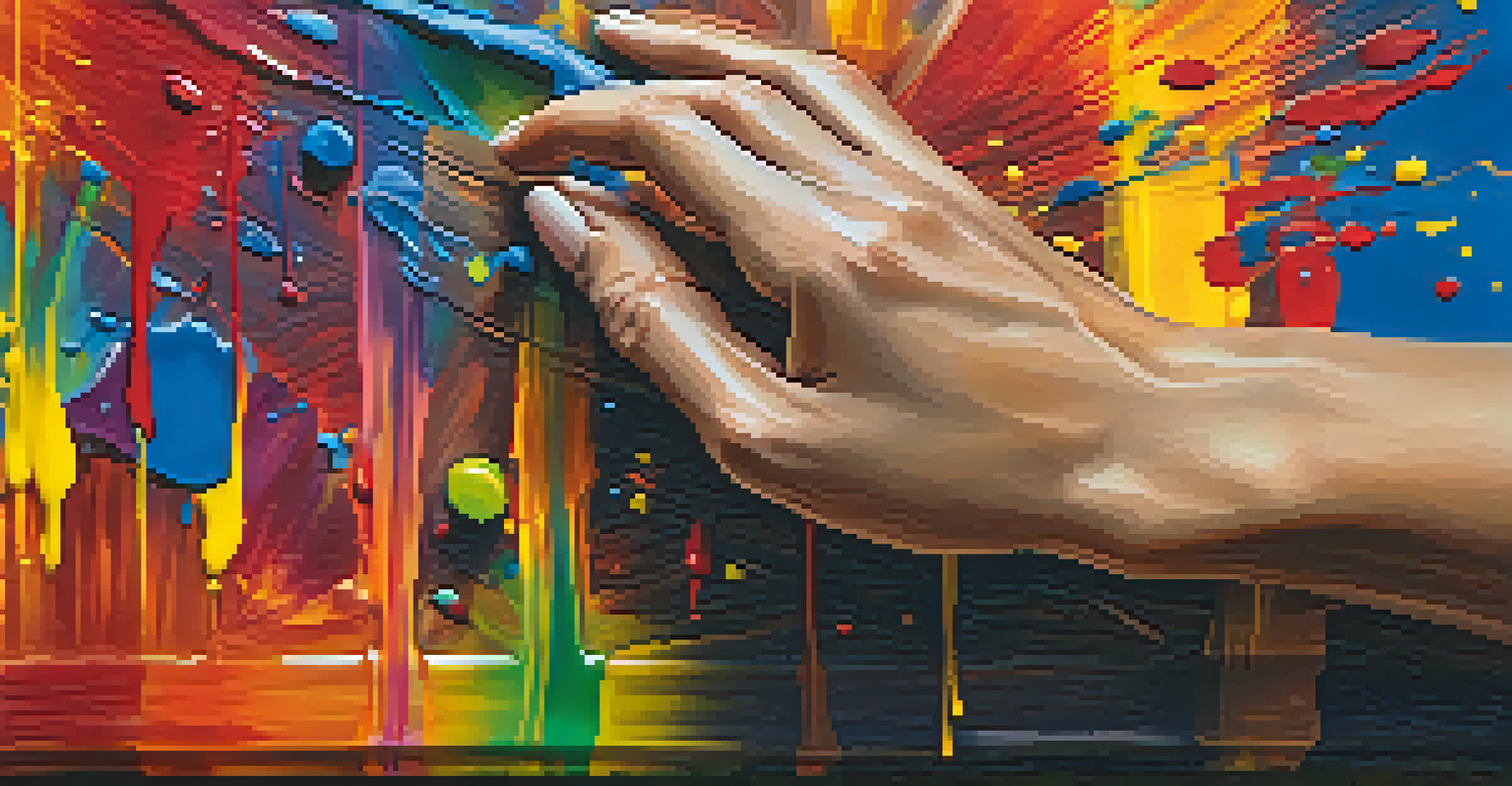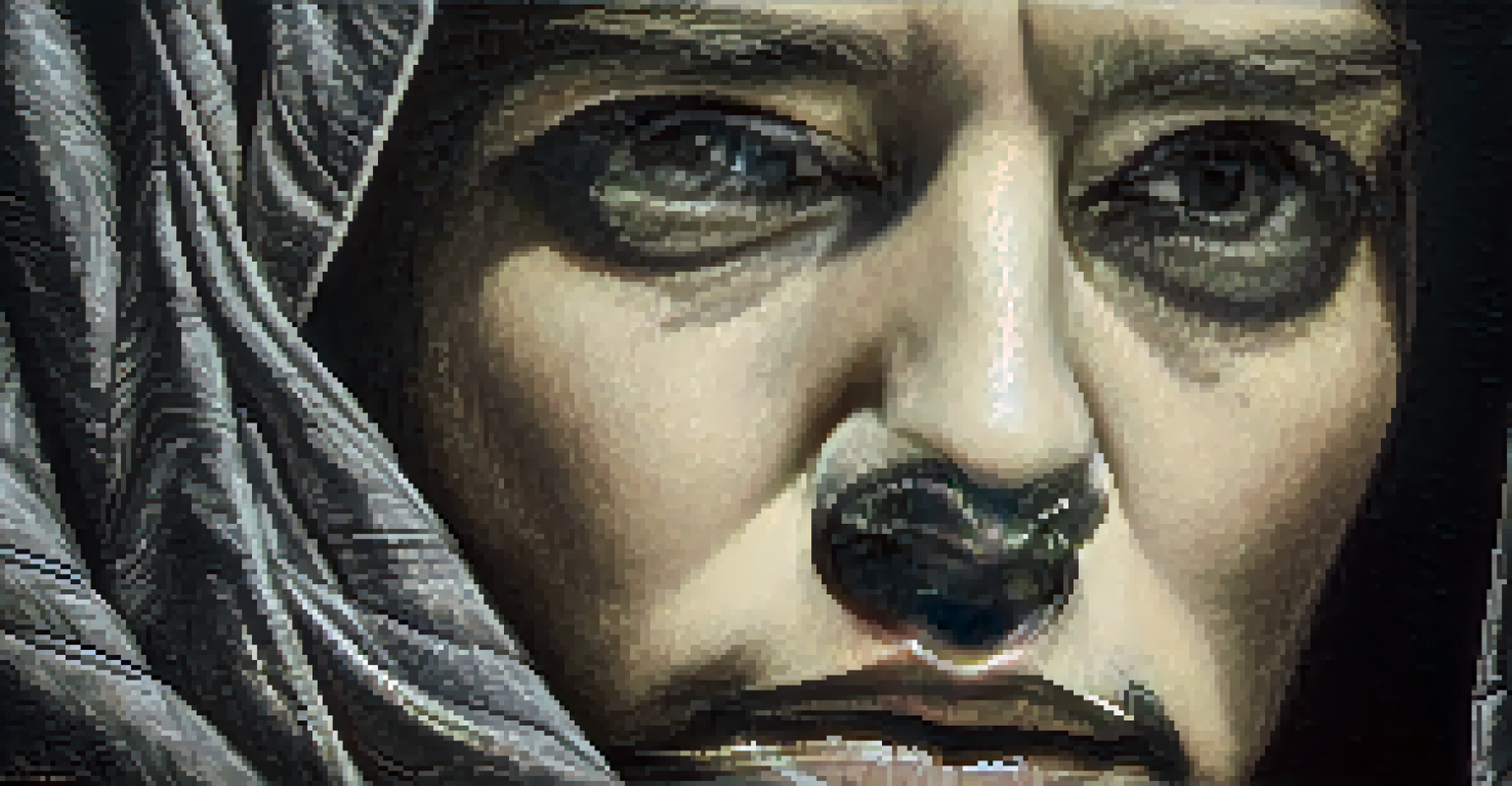Emotion in Art: Capturing Joy and Sorrow Across Time

The Role of Emotion in Artistic Expression
Art has always been a mirror reflecting the human experience, capturing our deepest emotions. Artists use their craft to convey feelings such as joy and sorrow, drawing viewers into their world. Whether it's a painting, sculpture, or a piece of music, emotions serve as the core inspiration behind the work.
Art is the most beautiful of all lies.
For instance, think about Edvard Munch's 'The Scream', a powerful representation of existential angst. The swirling colors and distorted figure vividly express the anguish of the human condition. In contrast, works like Claude Monet's 'Impression, Sunrise' radiate warmth and happiness, showcasing the beauty of a serene morning.
By understanding how emotions shape art, we can appreciate the layers of meaning behind each piece. Artists often channel their personal experiences, allowing us to connect with their stories and feelings. This emotional connection is what makes art so compelling and timeless.
Joyful Expressions in Art: A Celebration
Joy in art often manifests through bright colors, lively subjects, and dynamic compositions. Throughout history, artists have sought to capture moments of happiness, celebration, and beauty in their work. From the exuberance in Henri Matisse's 'The Dance' to the joyful landscapes of Van Gogh, joy is a powerful force.

Consider the vibrant colors and rhythmic movement in Matisse's work, which invites viewers to feel the energy of life itself. Similarly, Van Gogh's 'Starry Night' reflects a sense of wonder and joy in nature, even amidst turmoil. These joyful expressions resonate with audiences, providing a sense of upliftment and inspiration.
Art Reflects Human Emotions
Art serves as a mirror to our emotions, allowing artists to express feelings like joy and sorrow in ways that resonate deeply with viewers.
The celebration of joy in art not only showcases the beauty of life but also encourages viewers to reflect on their own moments of happiness. By immersing ourselves in these artistic expressions, we can experience the joy they convey and perhaps find our own sources of happiness.
Sorrow in Art: A Deep Dive into Pain
Sorrow is another profound emotion that artists have explored across different mediums. This expression often involves darker tones, somber themes, and haunting imagery that resonate with the viewer's own experiences of loss or heartbreak. The power of sorrow in art lies in its ability to evoke empathy and understanding.
The painter tries to master color, the musician tries to master sound, but the poet tries to master emotion.
Take, for instance, Pablo Picasso's 'Guernica', which vividly portrays the anguish of war and suffering. The monochromatic palette and distorted figures create a sense of chaos and despair that leaves a lasting impact. Similarly, Frida Kahlo's self-portraits delve into her personal pain, reflecting her tumultuous life and emotional struggles.
Artistic representations of sorrow allow us to confront our feelings and find solace in shared experiences. They remind us that we are not alone in our struggles and that pain can be a source of connection and healing. Through sorrow, art offers a space for reflection and understanding.
Historical Perspectives on Emotion in Art
Throughout history, the depiction of emotion in art has evolved, influenced by cultural and societal changes. In ancient times, art often celebrated gods and heroes, reflecting joy and triumph. As societies progressed, artists began to delve deeper into the complexities of human emotion, including sorrow and despair.
During the Renaissance, artists like Michelangelo and Raphael explored the human condition, showcasing both joy and grief in their works. The Baroque period further emphasized emotion, with artists using dramatic lighting and movement to evoke feelings. This ongoing evolution reflects humanity's changing relationship with emotion.
Historical Evolution of Emotion
The depiction of emotion in art has evolved over time, influenced by cultural changes and reflecting society's complex relationship with feelings.
Understanding these historical perspectives enriches our appreciation of art. Each era brought unique interpretations of joy and sorrow, influencing the way we perceive emotions today. By examining the past, we can gain insights into how art continues to shape and reflect our emotional landscape.
Modern Interpretations of Emotion in Art
In contemporary art, the exploration of emotion has taken on new forms and contexts. Artists now use various mediums, from digital art to performance, to convey complex feelings. This shift allows for a broader range of emotional expression, often challenging traditional boundaries.
For example, artists like Yayoi Kusama use immersive installations to evoke feelings of joy and wonder, while others, like Damien Hirst, explore themes of mortality and sorrow. The use of technology and mixed media has enabled artists to reach audiences in innovative ways, creating emotional experiences that resonate deeply.
Modern interpretations of emotion in art encourage viewers to engage actively with the work. They invite us to explore our feelings and interpretations, fostering a dialogue about the human experience. This dynamic relationship between art and emotion continues to evolve, reflecting the complexities of our modern lives.
The Therapeutic Power of Emotion in Art
Art has long been recognized for its therapeutic benefits, providing a means for individuals to express and process their emotions. Engaging with art, whether by creating or observing, can be a powerful outlet for both joy and sorrow. This therapeutic approach allows for personal reflection and healing.
For instance, art therapy is often used to help individuals cope with trauma or loss. Through the creation of art, people can express feelings that may be difficult to articulate verbally. This process not only fosters emotional release but also promotes self-discovery and growth.
Art as a Therapeutic Outlet
Engaging with art offers therapeutic benefits, helping individuals process emotions and promote personal reflection and healing.
The therapeutic power of emotion in art underscores its significance in our lives. By embracing our feelings through artistic expression, we can cultivate a deeper understanding of ourselves and our experiences. This connection to art can ultimately lead to healing and empowerment.
Embracing Emotion in Our Own Artistic Journeys
As we explore the world of emotion in art, we are reminded of the importance of embracing our feelings in our own artistic journeys. Whether you are a seasoned artist or a beginner, allowing your emotions to guide your creativity can lead to powerful and authentic expressions. Art becomes a personal narrative, reflecting our unique experiences.
Consider keeping a journal or sketchbook where you can freely express your emotions through writing, drawing, or painting. This practice can help you tap into your inner feelings, leading to deeper artistic exploration. Don't be afraid to experiment with different mediums to find what resonates with you.

Embracing emotion in your art not only enriches your creative process but also fosters a connection with others. When we share our emotional journeys through art, we invite others to reflect on their own experiences. In this way, art becomes a shared language, bridging the gap between joy and sorrow.